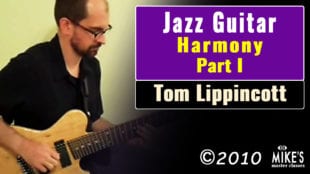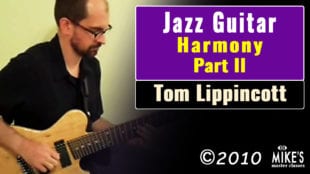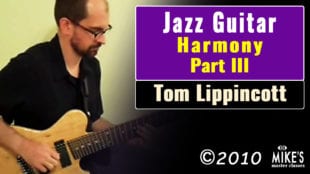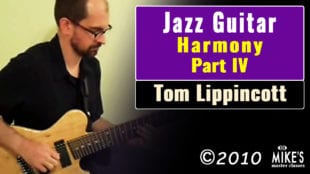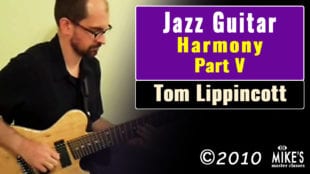Jazz Guitar Harmony Series
+Learning jazz guitar can be difficult whether a person is just starting out or has been honing his skills for years. In this five-part series presented by renowned jazz guitarist Tom Lippincott, jazz musicians will enjoy the benefit of an expert when it comes to jazz guitar harmony. Both beginning jazz guitarists and those who hope to brush up on the skills that will enhance their careers will appreciate Lippincott’s direct approach to jazz guitar harmony. Each lesson includes theoretical concepts as well as practical examples of real-world application. The following provides an overview of key concepts covered by each lesson.
Part I: Building a Strong Foundation
The series begins with a basic overview of key concepts that jazz guitarists use to enhance their craft. Building a strong foundation of techniques will help enhance a jazz guitarist’s career, and Lippincott introduces basic music theory along with traditional intervals and chord construction. Beginners especially will appreciate the reinforced note names and the foundational techniques, which form the basis for subsequent lessons. Throughout the first lesson, he explores concepts such as dual tonality and embellished melodies, noting that the way two notes move against each other forms the foundation of jazz harmony. The lesson includes five pages of written exercises and musical examples.
Part II: Triads and Diatonic Harmony
In the second part, Lippincott establishes the major uses of triads in jazz guitar and how mastering the concept of triads forms an essential part in honing overall skill. He insists that learning the triads conceptually rather than by muscle memory will help musicians not only master their form but will also enhance their overall sound. He also introduces the concept of shell voicings, a series of practical chords that can be built upon in later development. Using simple, straightforward instruction, Lippincott attempts to explain complex chord structure in clear and concise instruction. The lesson includes nine pages of written examples along with musical exercises.
Part III: Enhancing the Triads
Building upon the concepts introduced in Part II, Lippincott develops the concept of triads further in Part III. Recognizing the use of different positions to enhance triad development, he encourages improvisation through aural training and a theoretical knowledge of both open and closed positions. Triads can be used with other chord structures, and Lippincott shows musicians how to transport this musical concept to additional keys. With 10 pages of written examples and various musical exercises, Part III helps reinforce the concept of triads while further adding to the musician’s repertoire of fundamental techniques.
Part IV: Shell Voicings Techniques
Certain chord structures sound naturally dissonant to the human ear, which may be beneficial depending on the situation. For the most part, however, dissonant chords strike the wrong emotional note. In Part IV, Lippincott expands on the concept of color tones and shell voicings techniques. Using color tones, musicians can fill out the voice and sound of a chord, changing its entire function and emotional perception. Using shell voicings, color tones and examples with and without roots, Lippincott reinforces the basic concepts while building on advanced techniques. Part IV includes musical exercises and 11 written pages of examples.
Part V: Developing Mastery
As the culmination for the five-part series, Part V expands on the foundational concepts learned in the previous sections. For advanced jazz guitarists or those who need to develop their personal style, Part V re-imagines traditional positions on the fingerboard as a way to develop chord structures. Lippincott introduces the terms “drop 2” and “drop 3” and provides examples both in theory and practical application for jazz guitar harmony. He also includes the concept of chord synonyms to help expand on well-known voicings. With 16 pages of written examples and musical exercises, Part V offers a variety of musical theory and practical application designed to further enhance a jazz guitarist’s skill set.

